StoreSEO helps optimize SEO for Shopify products so that they have more online visibility among your potential customers. StoreSEO ensures everything is in order by showing an SEO score and all the fields that need to be fixed to bring a good SEO score for your product page. Learn how StoreSEO will help Optimize SEO for Shopify products from the guidelines below.
Before you start, make sure you have created or added a product and installed StoreSEO app to your Shopify store. Then, follow these step-by-step guidelines to find out how to optimize the product page with StoreSEO.
Step 1: Navigate To StoreSEO Product Optimization #
Log in to your Shopify store. Then, from the search bar on the top or the ‘Apps’ option in the left sidebar, search for the StoreSEO app and click on it. From the StoreSEO dashboard, go to the ‘Optimize SEO’ tab. Now click on the ‘Products’ option.
Make sure to sync all products to see the product list on this page. Choose the product you want to optimize, and click on the ‘Fix issue’ button.
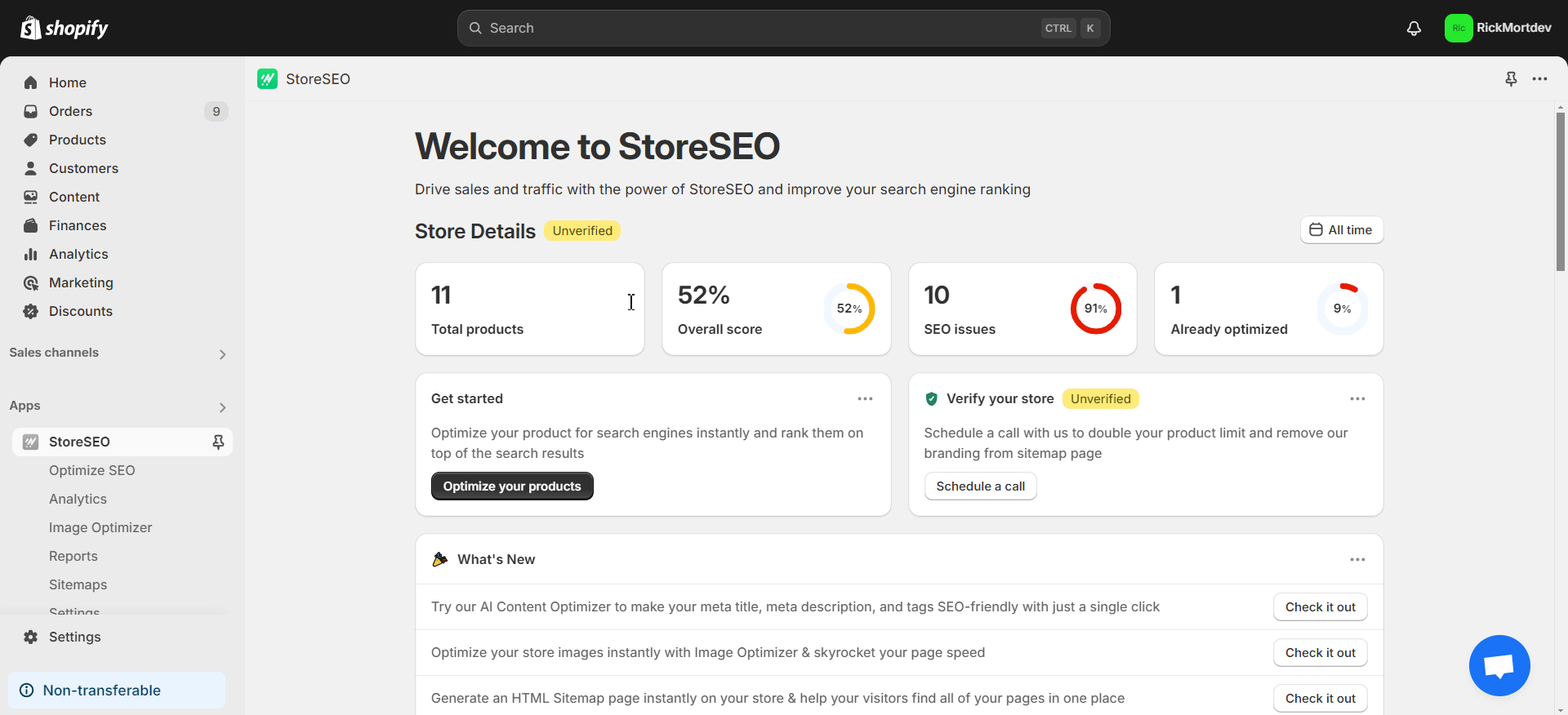
Step 2: Optimize Shopify Product #
Now, it is time to optimize the Shopify product page SEO. As you can see in the image below, the SEO details of your selected product are shown by StoreSEO. From the right side panel, you will also find Basic SEO Analysis and Detailed SEO Analysis to find the key factors that have to be addressed to improve the SEO Score.
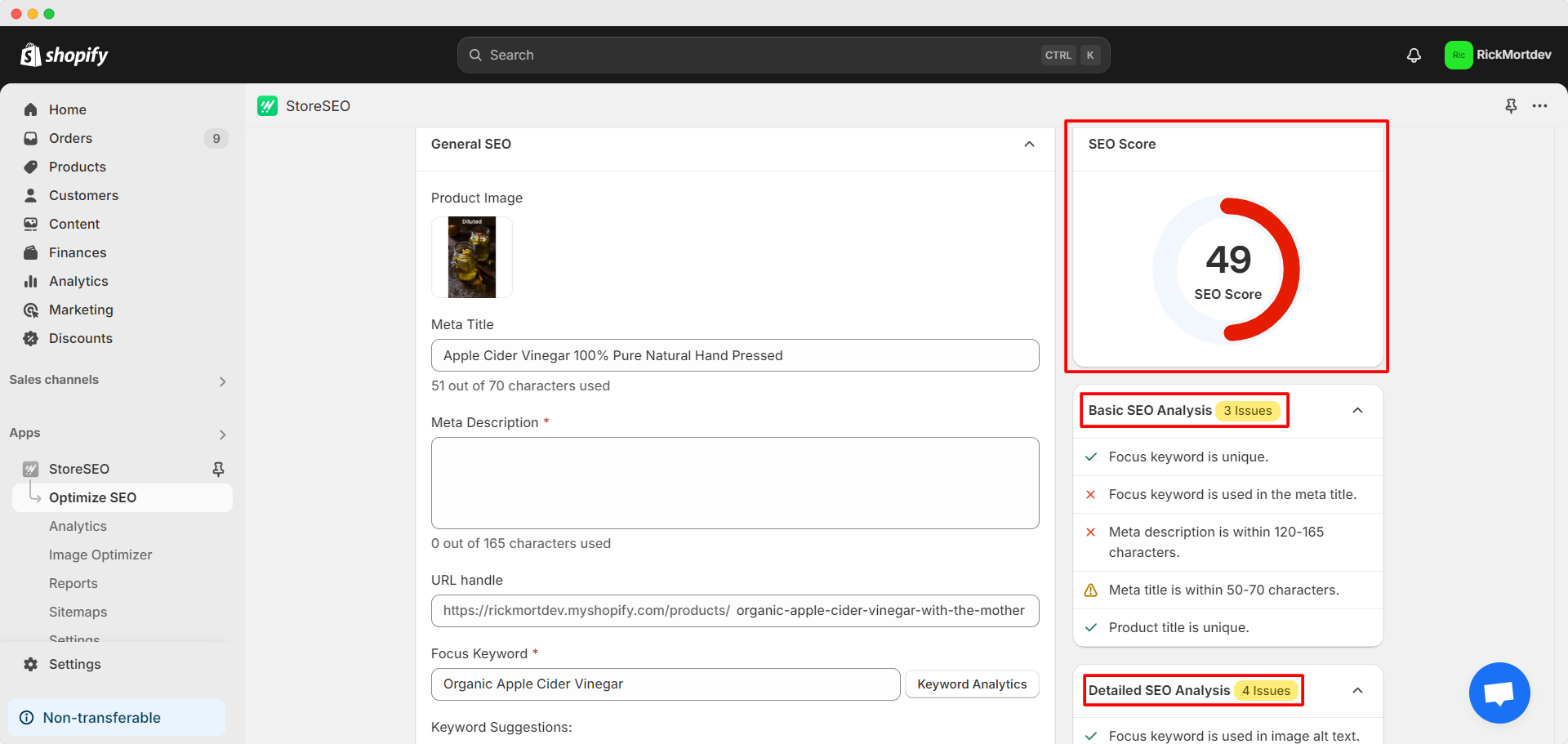
Basic SEO Analysis #
Let us start with Basic SEO Analysis. Here, we have to ensure various criteria such as placing a unique focus keyword in the required places, maintaining an optimized length of the meta title and description and others. We will now show you how to do these one by one.
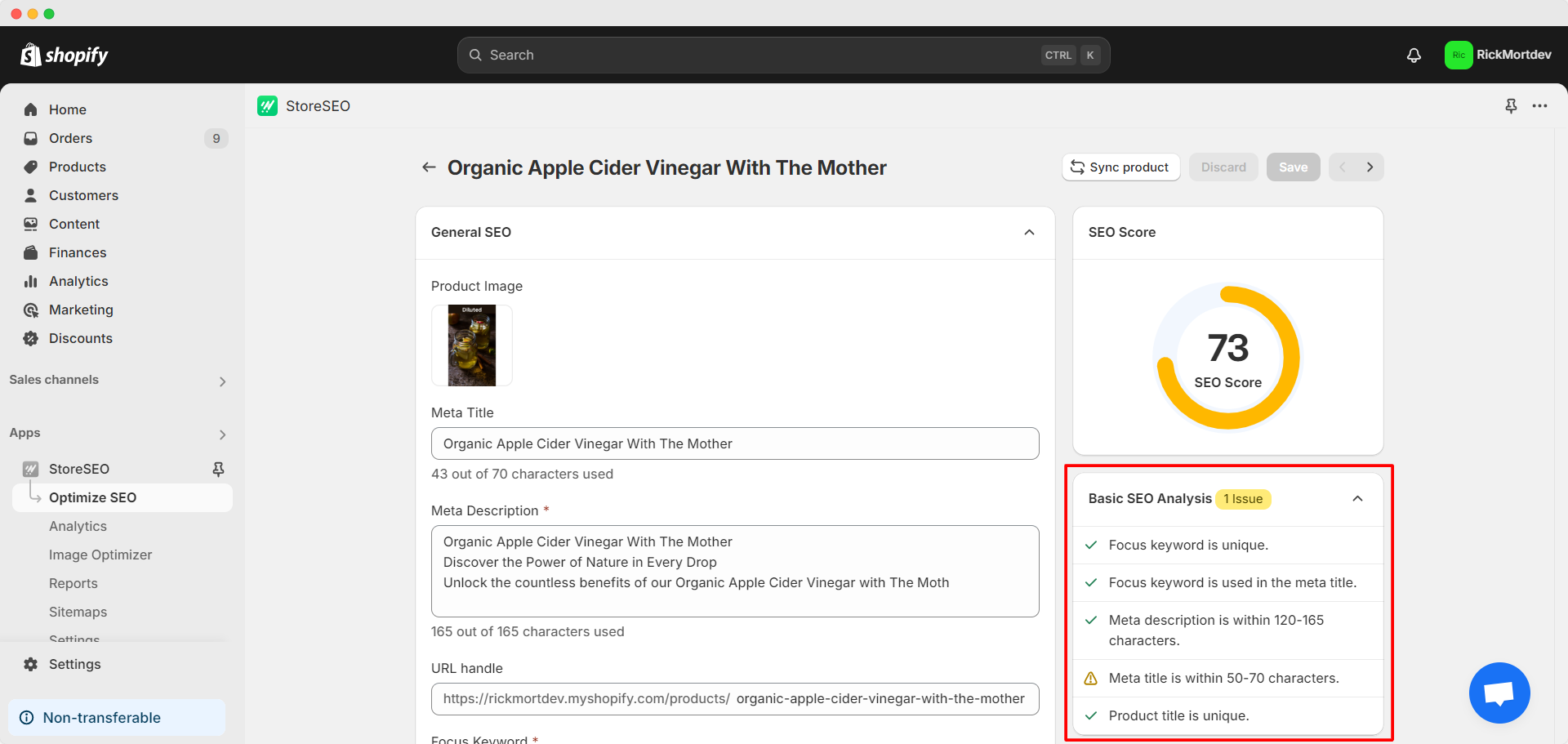
Focus keyword is unique
First, you need to choose the proper focus keyword. This is crucial because the product is indexed on search engines based on this keyword. To put it simply, your potential customers will have a higher likelihood of finding your product if their search keyword and your selected focus keyword match.
Therefore, you need to be very careful and do proper keyword research when choosing the focus keyword. Here are a few things to consider:
Keyword relevance: Make sure the keyword is relevant to your product, business, audience and niche. Suppose, you are selling apple cider vinegar. Your focus keyword should be relevant to this product. Now, you select a high search volume keyword containing the term ‘fresh apple’ or ‘apple iphone’. These keywords are outside your product niche. So although it might have a higher search volume, it will not be a relevant option.
Search volume: Keywords with higher search volume have more searches every month. If you select keywords with higher search volume, you are more likely to face more competition. The more specific keywords you use, the more precisely you can reach your target audience.
Now, if you choose a long focus keyword such as ‘original unfiltered organic apple cider vinegar’, you have a unique keyword but there is less possibility for customers to use this entire keyword during a search. This is why it does not have a good search volume as shown in the image below.
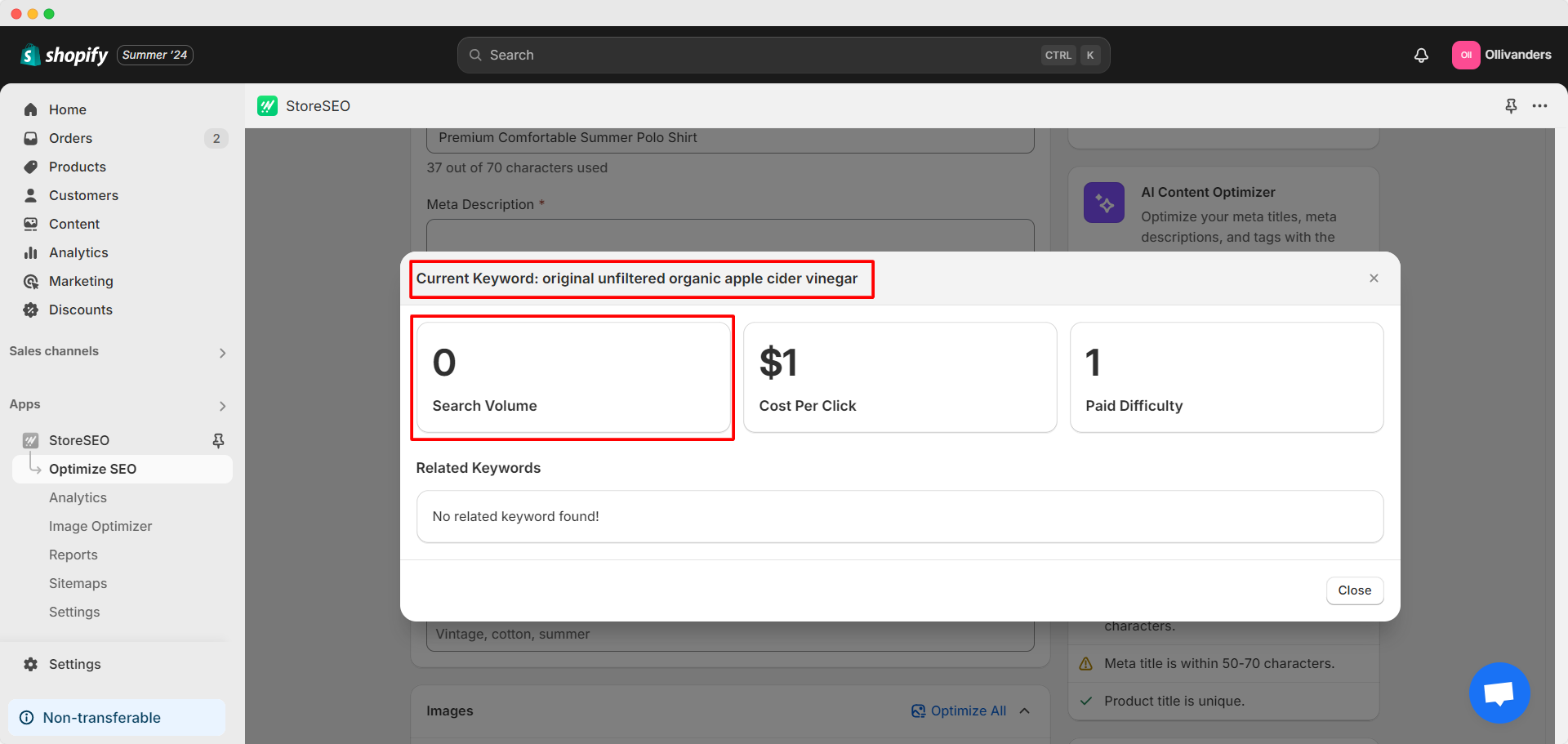
Now, if you choose a short focus keyword like ‘apple cider vinegar’, you will find it has a high search volume as shown in the image below. However, such popular keywords have too much traffic and will be a lot harder to rank and reach out to your audience.
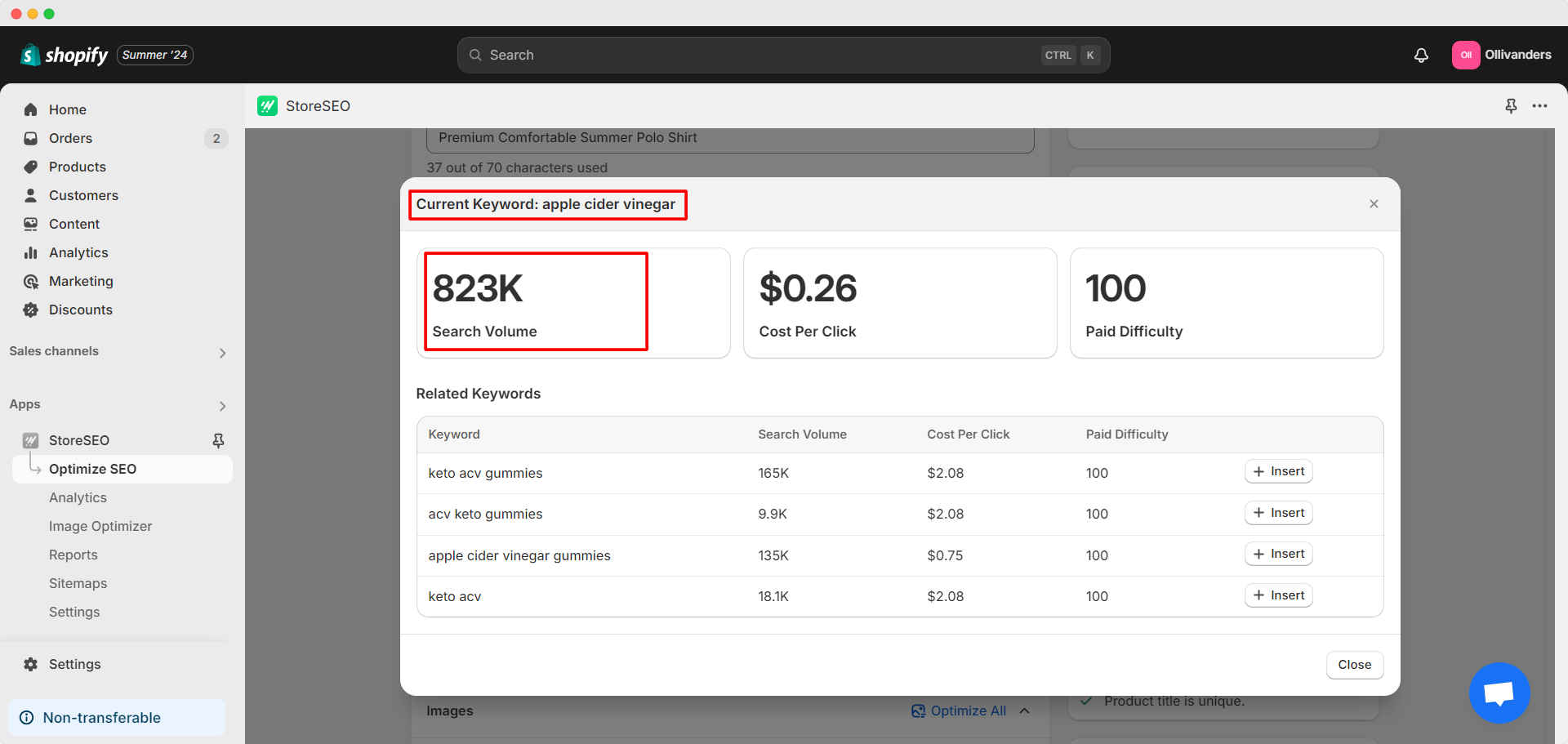
On the other hand, if you select the focus keyword ‘organic apple cider vinegar’, you have a good search volume (not too high) and there is a higher possibility to index without facing much competition. This is why this is the more appropriate focus keyword option in this particular case.
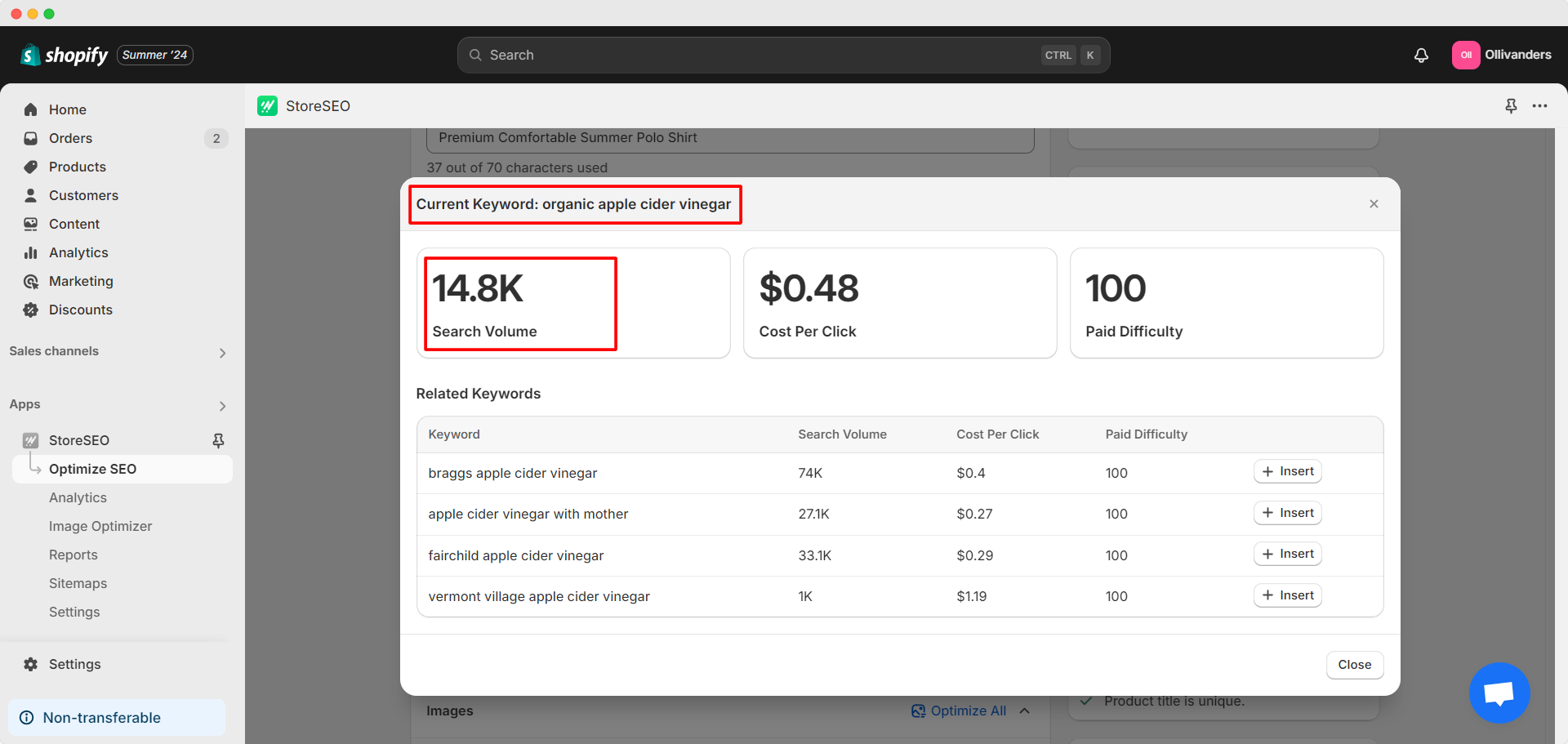
Cost per click: If you are running ads with particular keywords, the cost per click determines the approximate budget for the ad campaign. So, choosing keywords with a higher cost per click means you need to have a bigger campaign budget. Please note that it is an estimated value and you do not have to worry about it if you are not running any ads.
Paid difficulty: This represents the demand for keywords when used in paid ads. Higher paid difficulty indicates the keyword also has more competition in organic search. So, it is an important metric during keyword research.
Related keywords: Remember to check the related keywords for a particular keyword. These related keywords will give you additional keyword suggestions. So, you might come across a better focus keyword option. Make sure the related keywords suit your product, business, audience and niche.
Back to product optimization on StoreSEO, place your preferred keyword in the ‘Focus Keyword’ field. Click on the ‘Keyword Analytics’ button to instantly get the Search Volume, Cost Per Click, Paid Difficulty and related keywords for your keyword.
Here, we have selected ‘organic apple cider vinegar’ as the focus keyword. It is recommended that different focus keywords be used for different products. However, if your products are all similar, the same focus keyword can be used for them. Please choose a keyword according to your business. Do keyword research for Shopify for this.
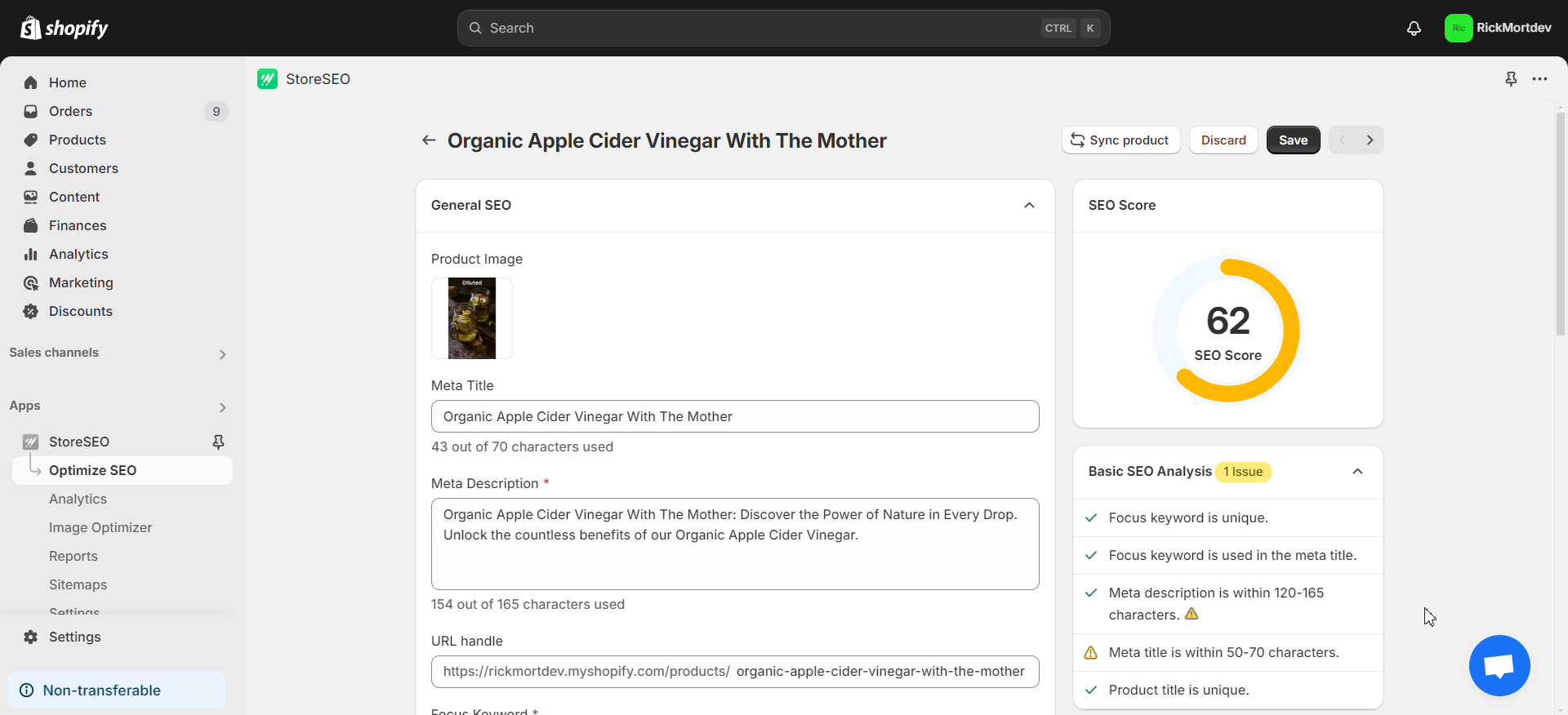
Focus keyword is used in the meta title
Your product’s meta title and meta description are the first things that customers see when exploring search engines. Therefore, both of these are very important and should be written carefully and properly. Now, make sure that the focus keyword is used in the meta title. As you can see in the image below, our meta title is the following:
Organic Apple Cider Vinegar 100% Pure Natural Hand Pressed
So, it contains our selected focus keyword (marked bold).
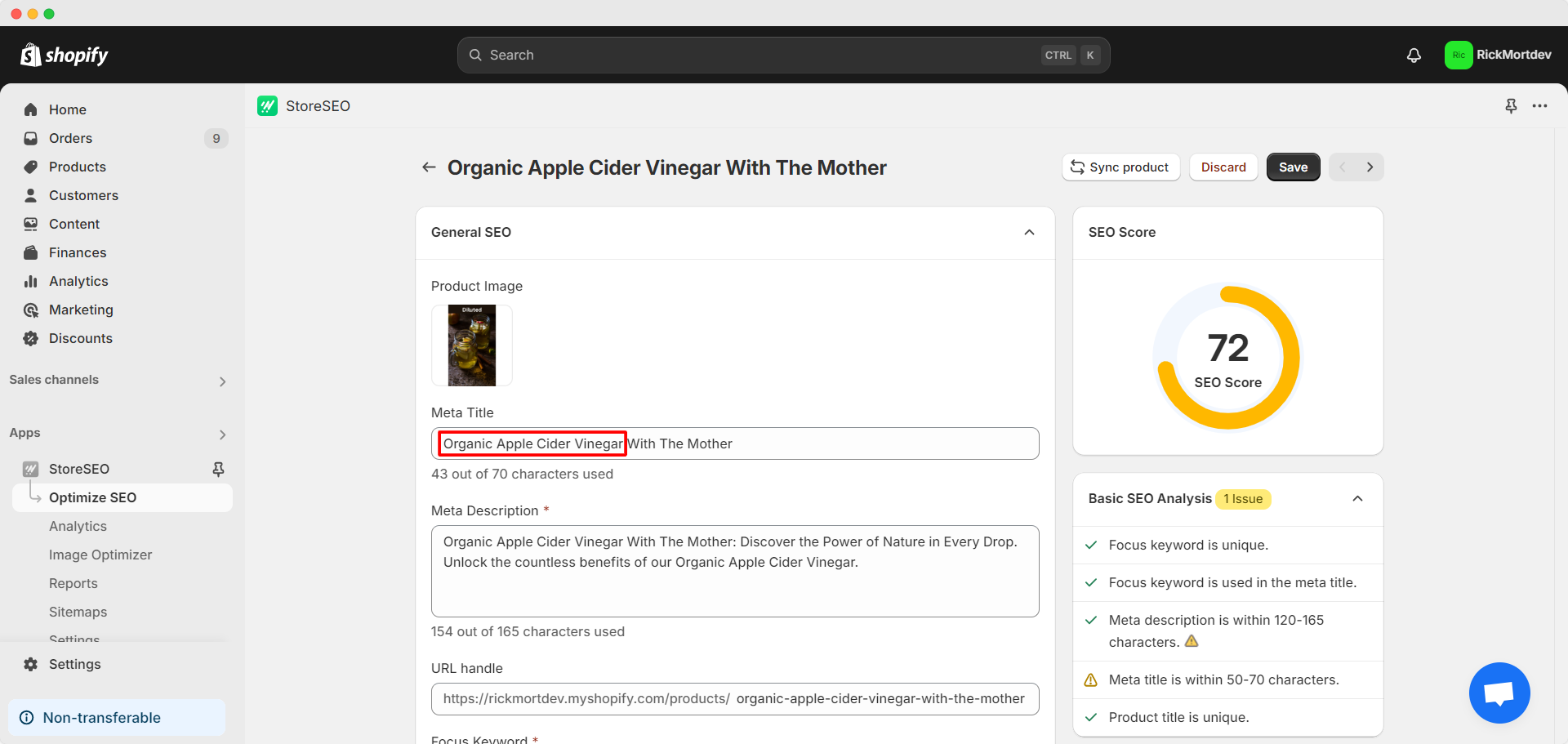
Meta description is within 120-165 characters
Your product’s meta description should be within 120-165 characters. It should also contain the focus keyword that you have selected. Our meta description is the following:
Discover the health benefits of our premium organic apple cider vinegar. Ideal for detox, weight loss, and overall wellness. Get it now at an amazing price.
As you can see, the meta description is 156 characters long so it meets the requirement of being within 120-165 characters.
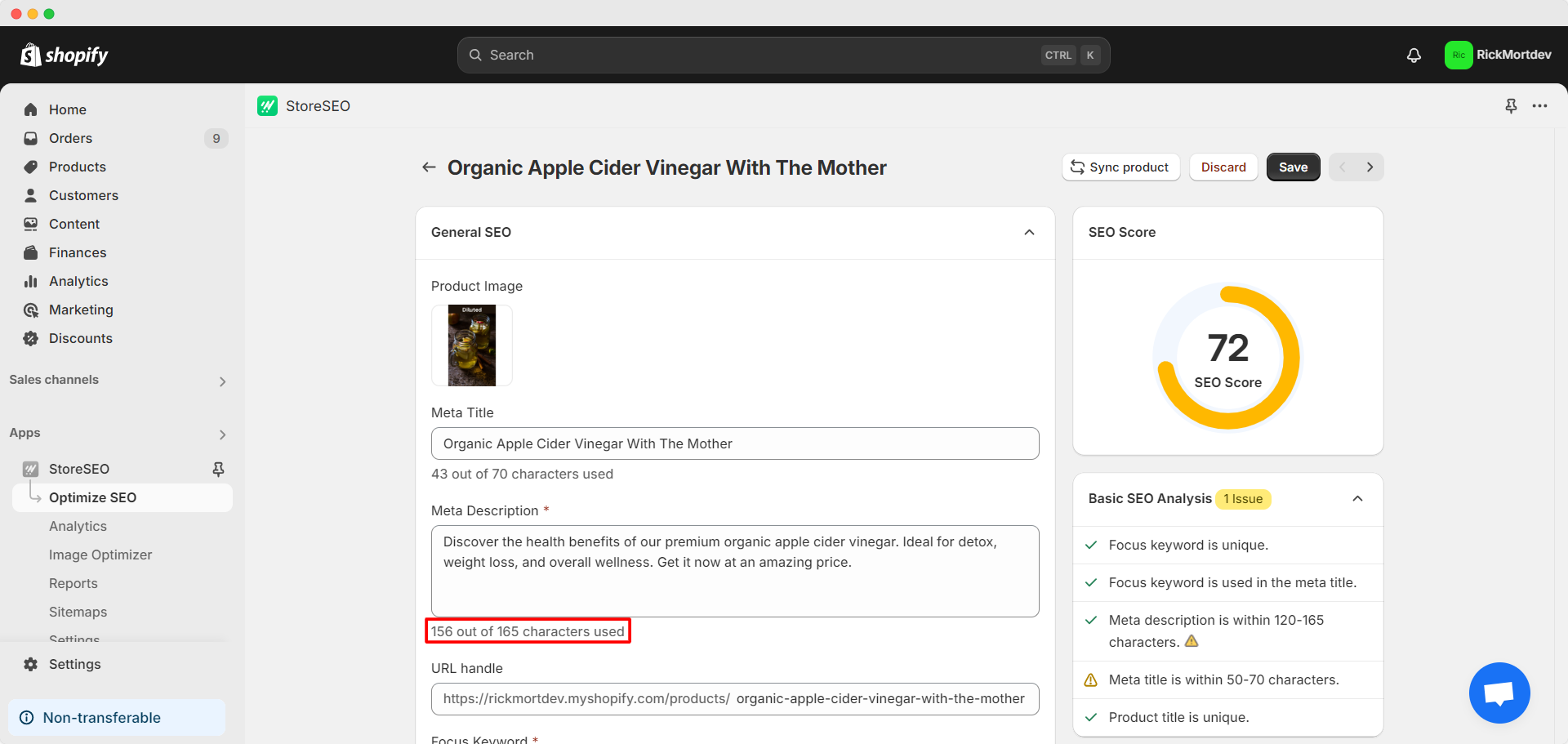
Meta title is within 50-70 characters
Keep your meta title within 50-70 characters. As you can see, our meta title is the following:
Organic Apple Cider Vinegar 100% Pure Natural Hand Pressed
It is 58 characters long so it meets the requirement.
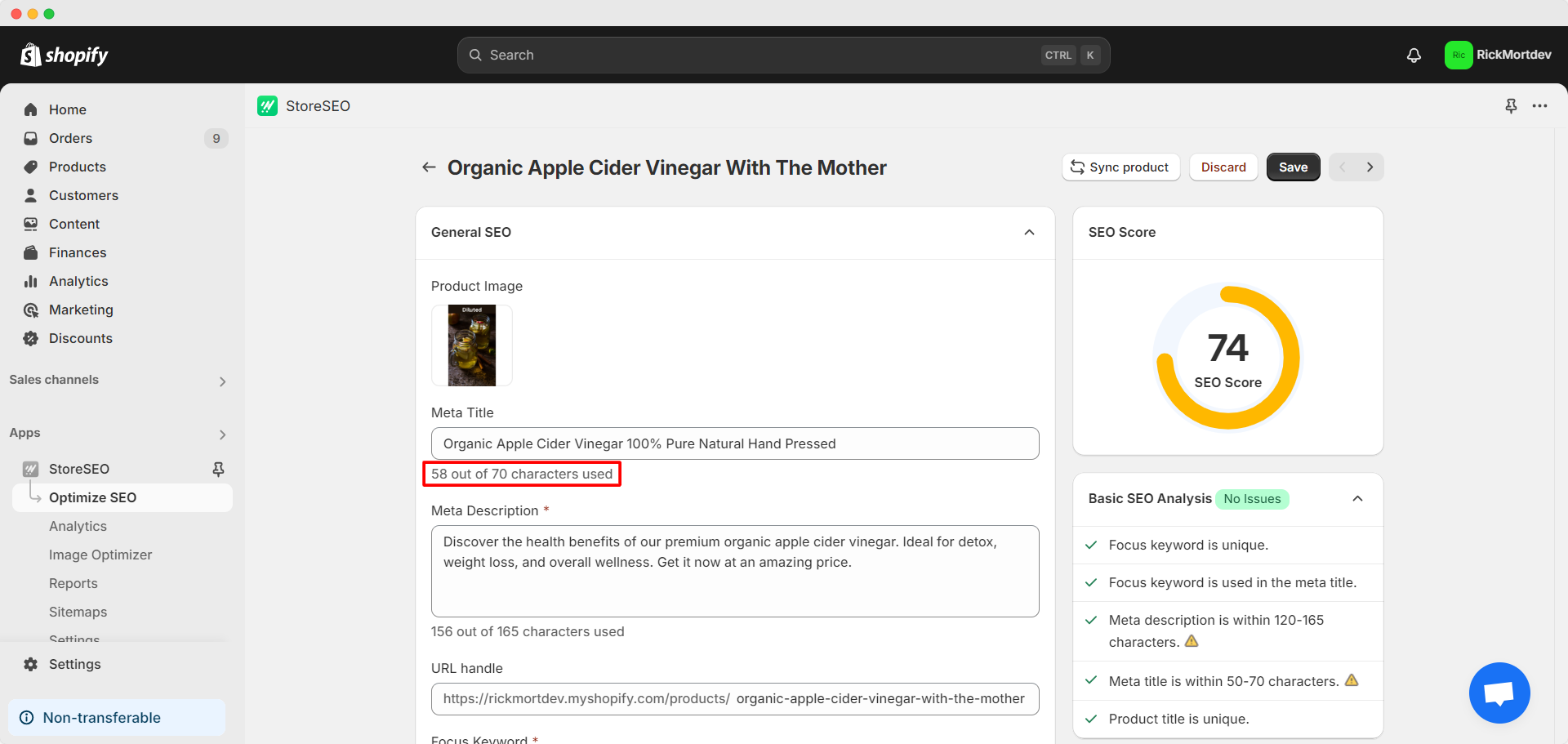
Product title is unique
Make sure the product title is unique. This means do not use the same product title for more than one product in your Shopify store. Remember this when adding a new product. Also, place your selected focus keyword in the product title.
When you do not have your focus keyword in the product title, it will show a cross mark in StoreSEO detailed SEO analysis. So, click on the ‘Edit product’ button and edit the product title from the ‘Title’ field. Make sure the product title contains the focus keyword in a sensible manner. Click on the ‘Save’ button once you are done.

As you can see, one of our product titles is ‘Organic Apple Cider Vinegar With The Mother’ which cannot be found in the title of any other product. It also contains our selected focus keyword.
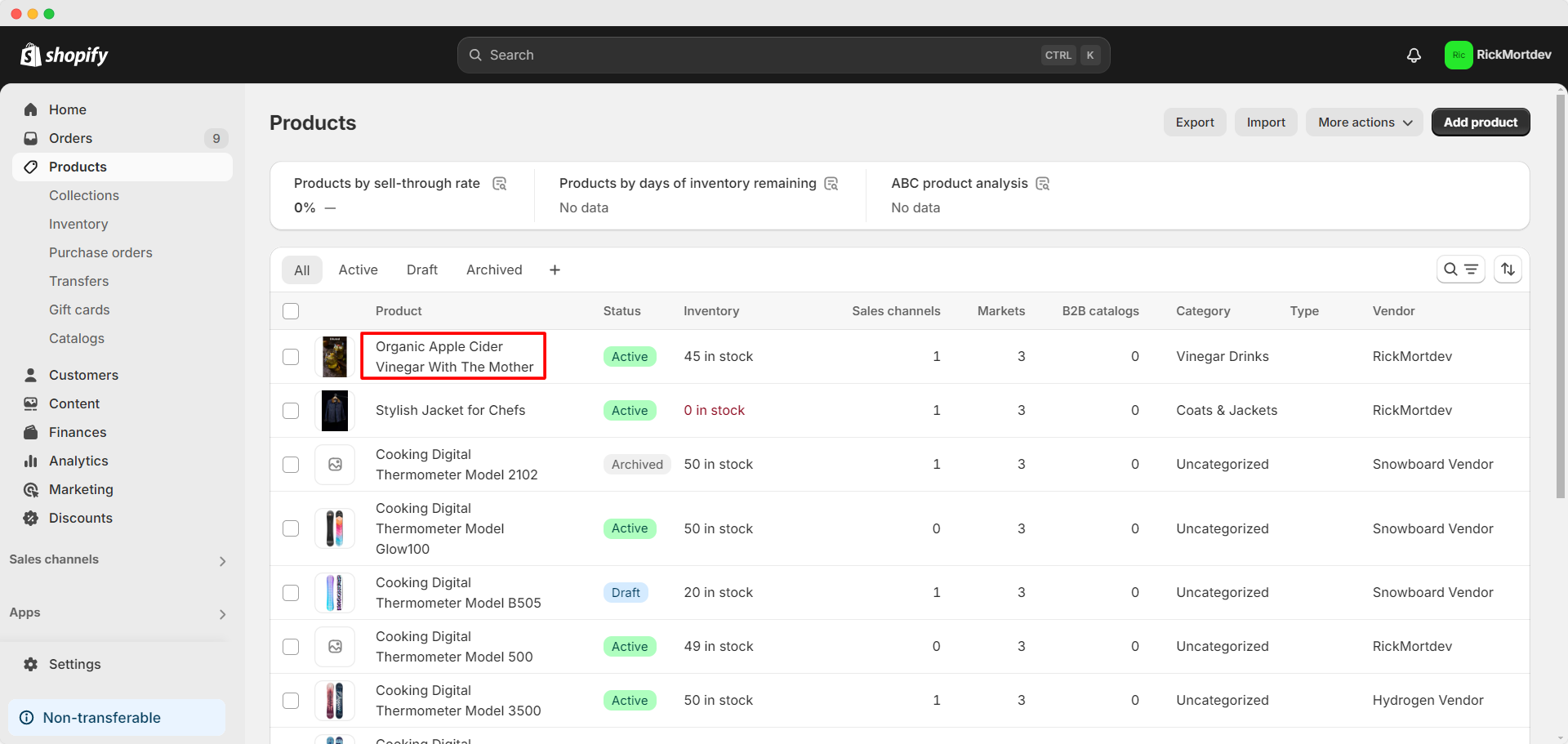
Detailed SEO Analysis #
We will now proceed to Detailed SEO Analysis. For this, we have to make sure that the focus keyword is placed in the image alt text, product title, meta description and URL and meet a few other requirements. Let us show you how to do all these.
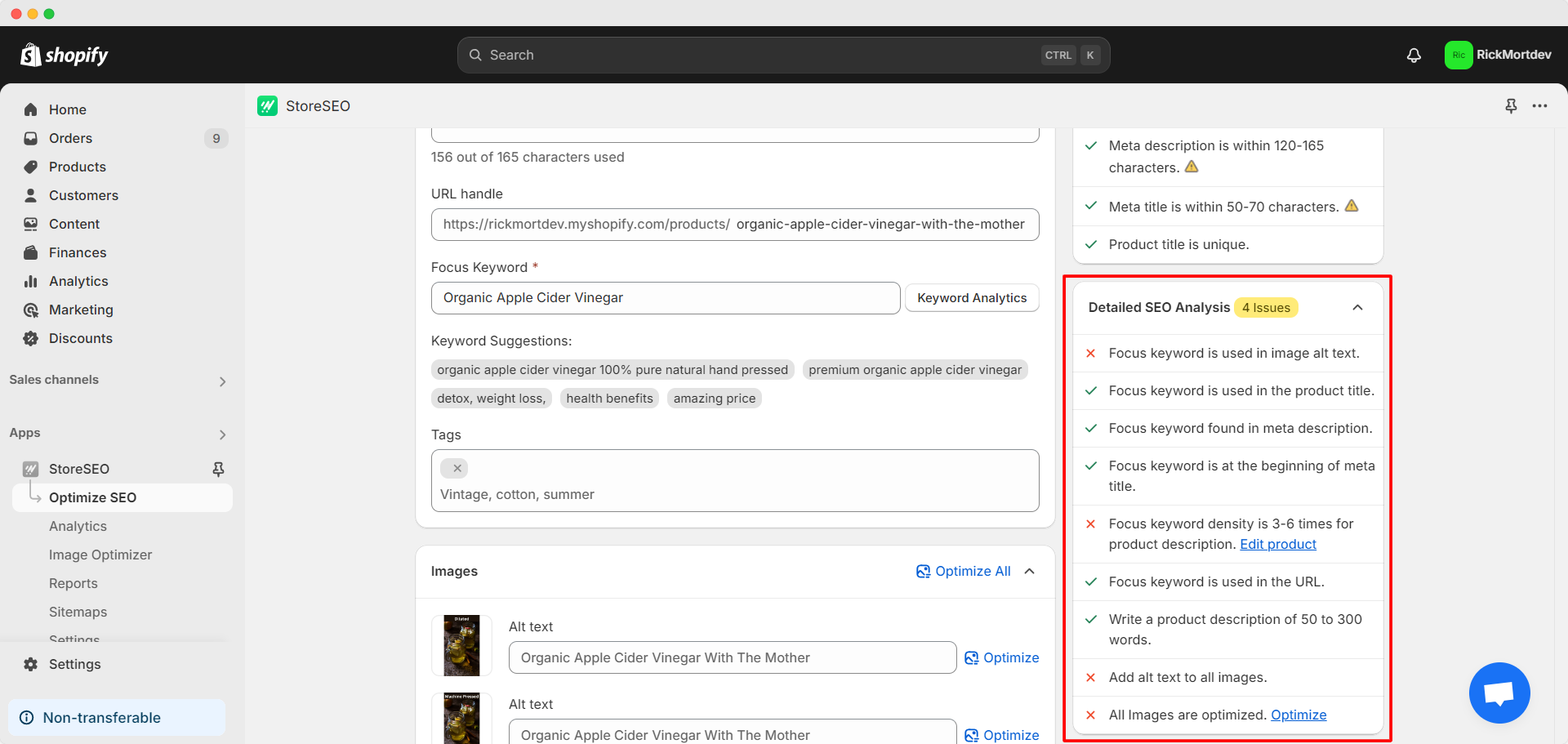
Focus keyword is used in image alt text
Scroll down and find the ‘Alt text’ fields. Here, make sure that the focus keyword is used in the image alt text. As you can see in the image below, all our Alt text fields contain Organic Apple Cider Vinegar (our selected focus keyword).
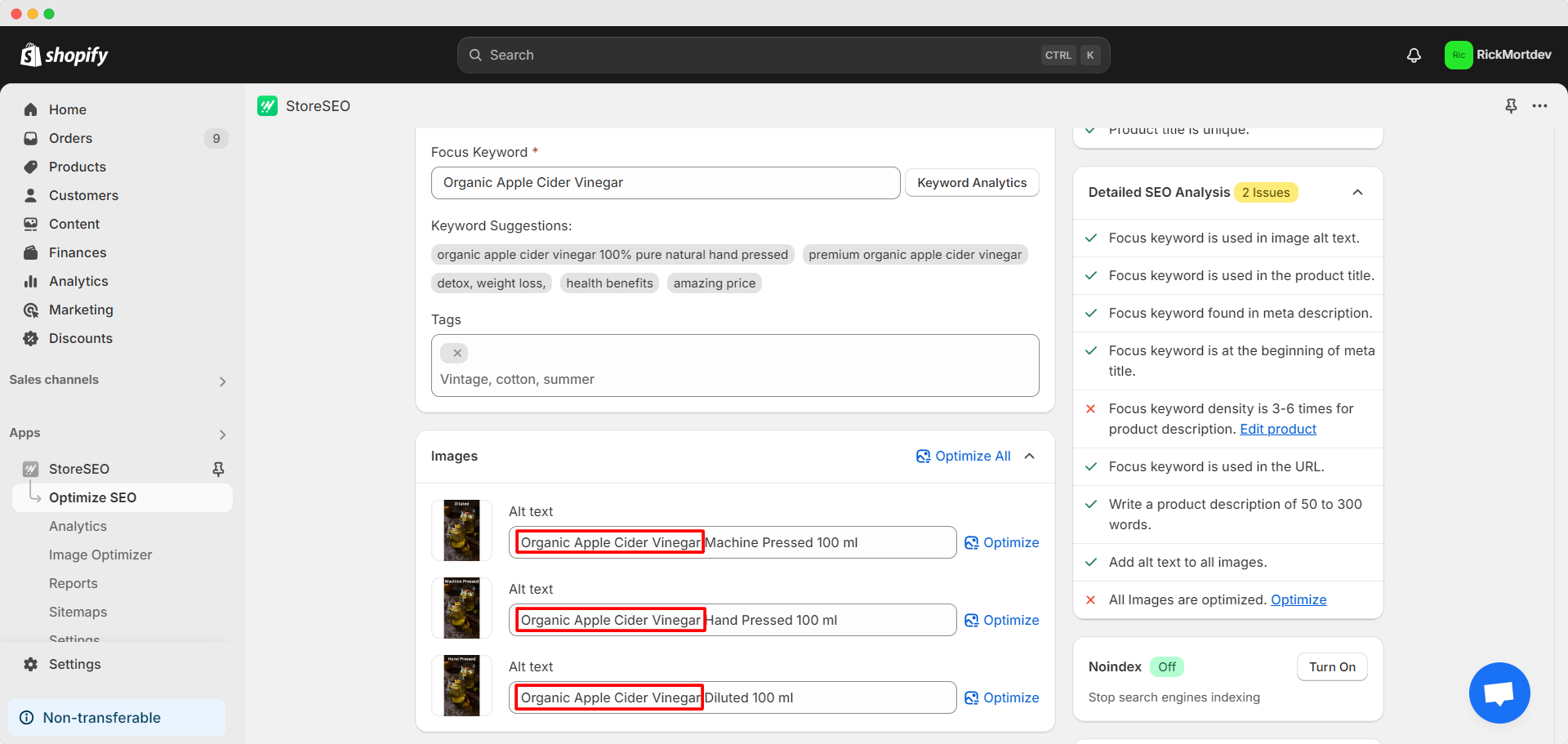
Focus keyword is used in the product title
When you do not have your focus keyword in the product title, it will show a cross mark in StoreSEO detailed SEO analysis. So, click on the ‘Edit product’ button and edit the product title from the ‘Title’ field. Make sure the product title contains the focus keyword in a sensible manner. Click on the ‘Save’ button once you are done.

As shown below, our product title contains ‘Organic Apple Cider Vinegar’ which is our selected focus keyword.
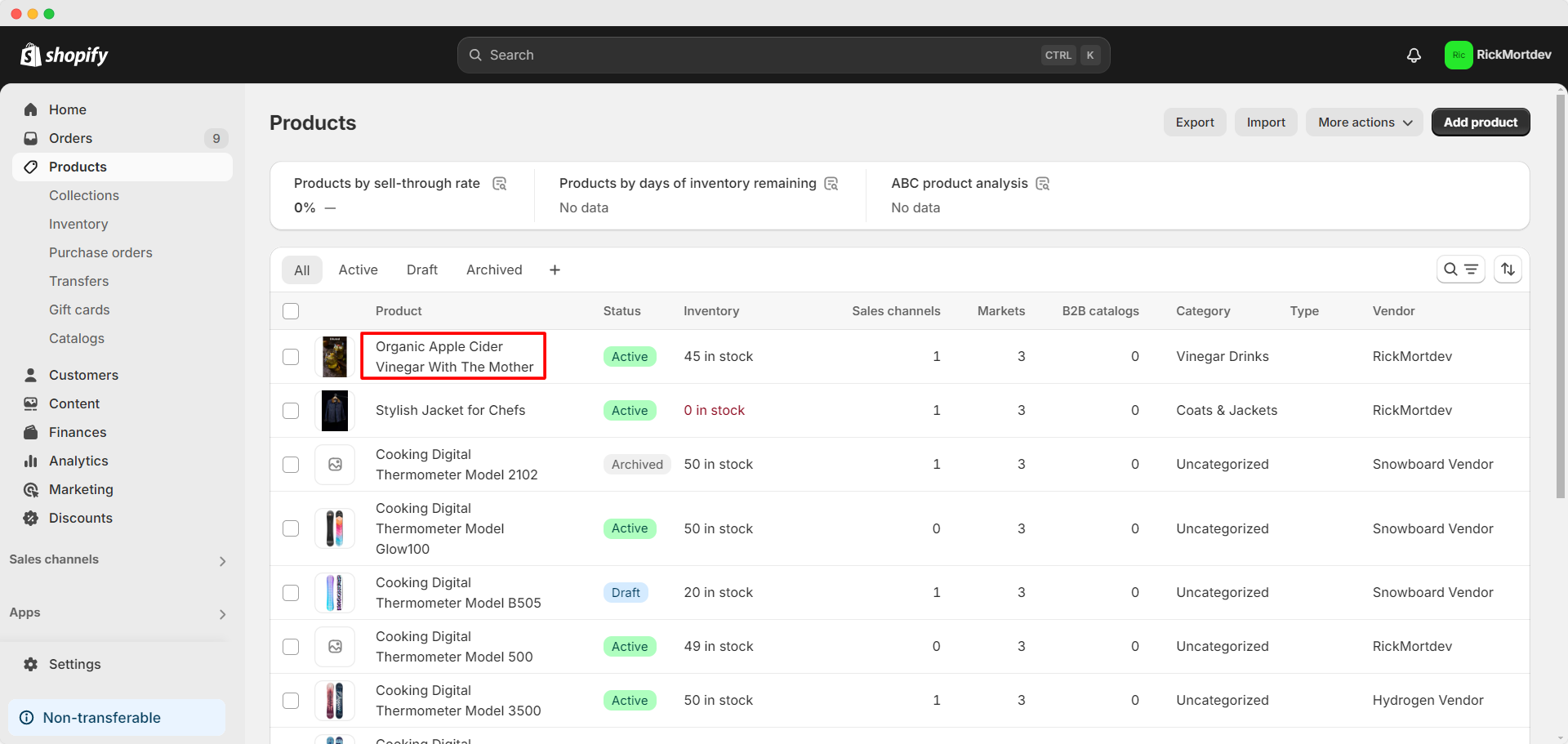
Focus keyword found in meta description
As we have shown previously, you have to place the focus keyword in the meta description. So, you can check it again to make sure that you have done it.
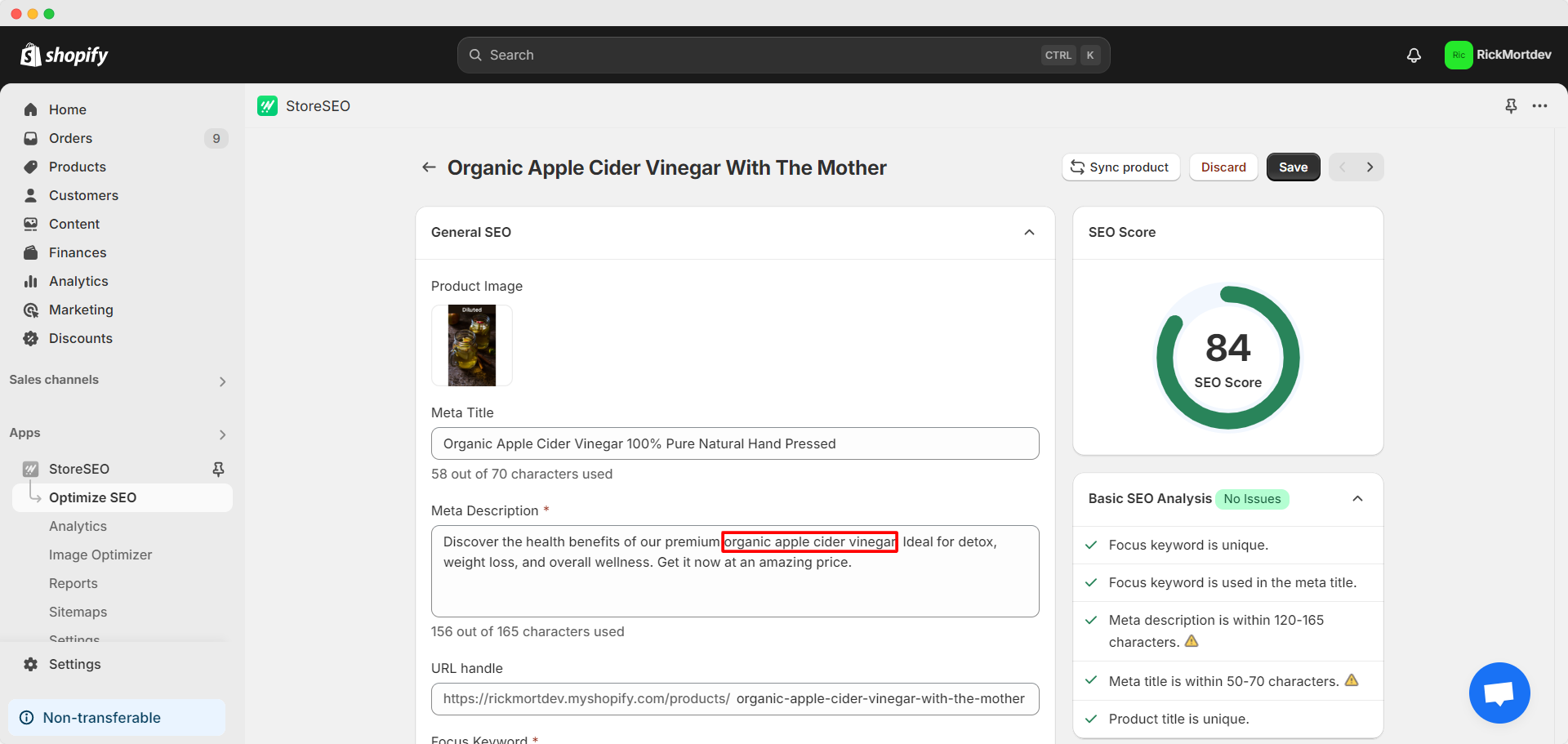
Focus keyword is at the beginning of meta title
Now, make sure that the focus keyword lies at the beginning of the meta title. As you can see in the GIF below, when we have done this the SEO score has noticeably improved.
This is our meta title:
Organic Apple Cider Vinegar 100% Pure Natural Hand Pressed
As you can see, the focus keyword ‘Organic Apple Cider Vinegar’ has been placed at the beginning.
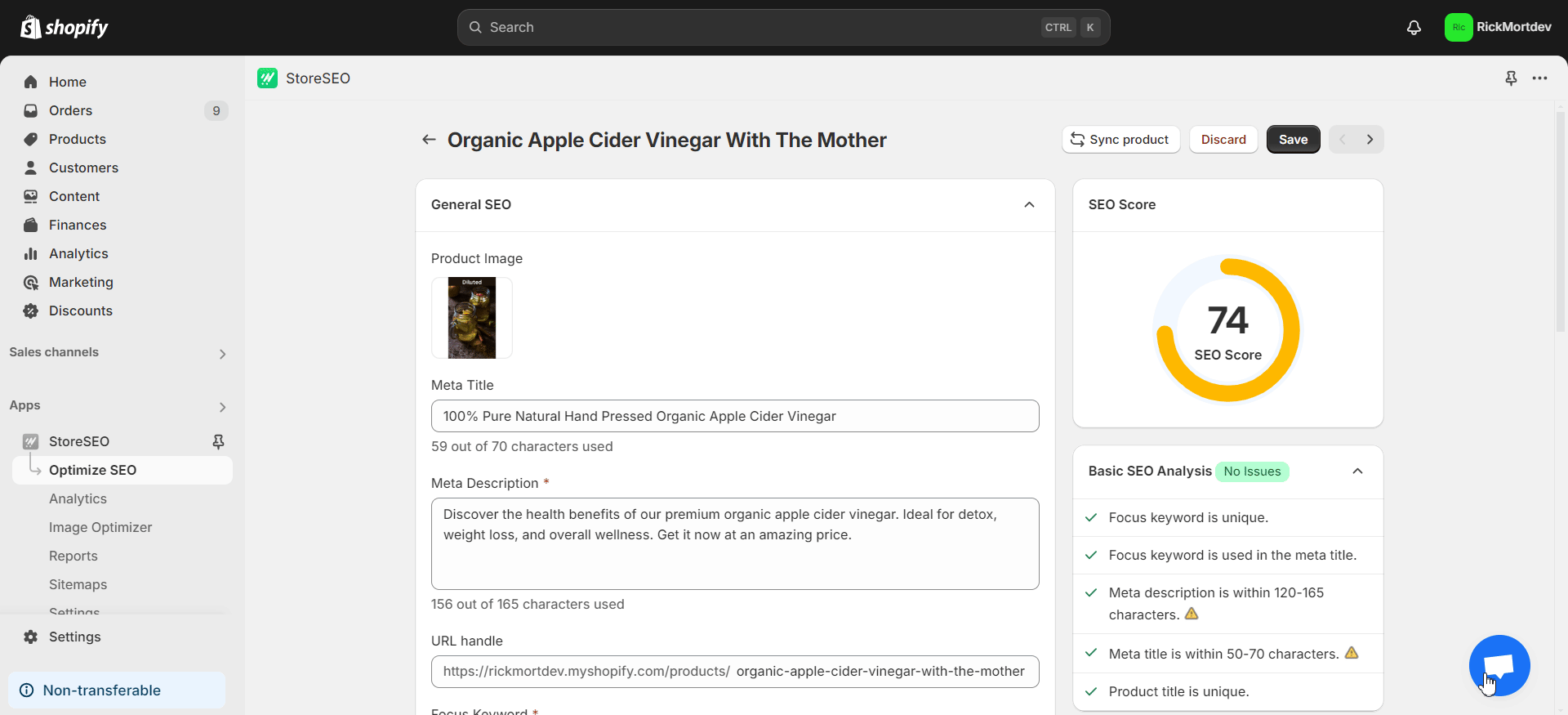
Focus keyword density is 3-6 times for product description
For this, from the Shopify dashboard, click on the ‘Products’ tab in the left sidebar. Select your desired product from the list. Now, make sure that the focus keyword density is 3-6 times in the product description without any keyword stuffing. We have used our focus keyword 6 times in the example below:
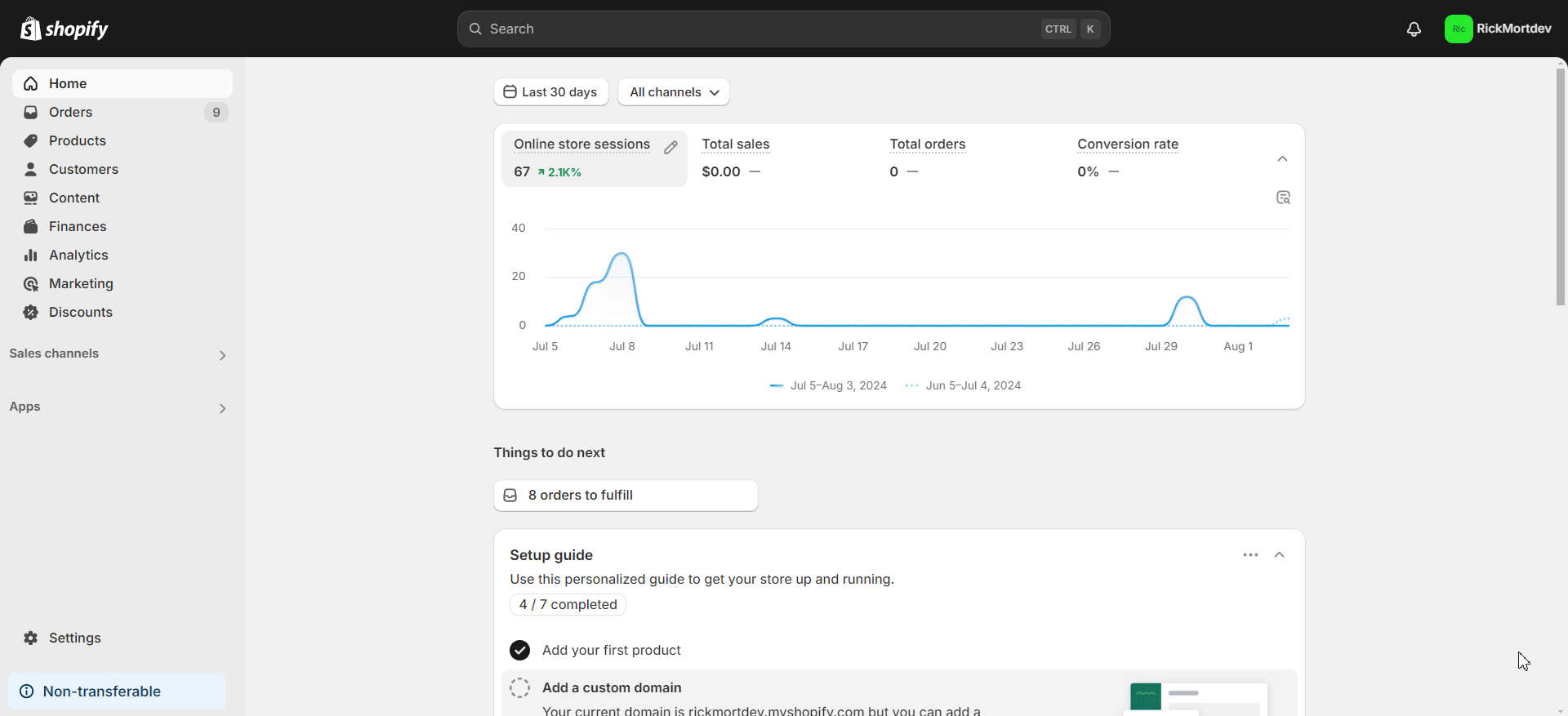
Focus keyword is used in the URL
Finally, make sure that the product URL contains the focus keyword. As you can see, the URL field contains ‘Organic Apple Cider Vinegar’ or our selected focus keyword.
Note: If your product has already been indexed and you want to change its URL, it is recommended to create a URL redirection. We are assuming that you are optimizing a new or your first store. In that case, it is best not to create any unnecessary redirections.
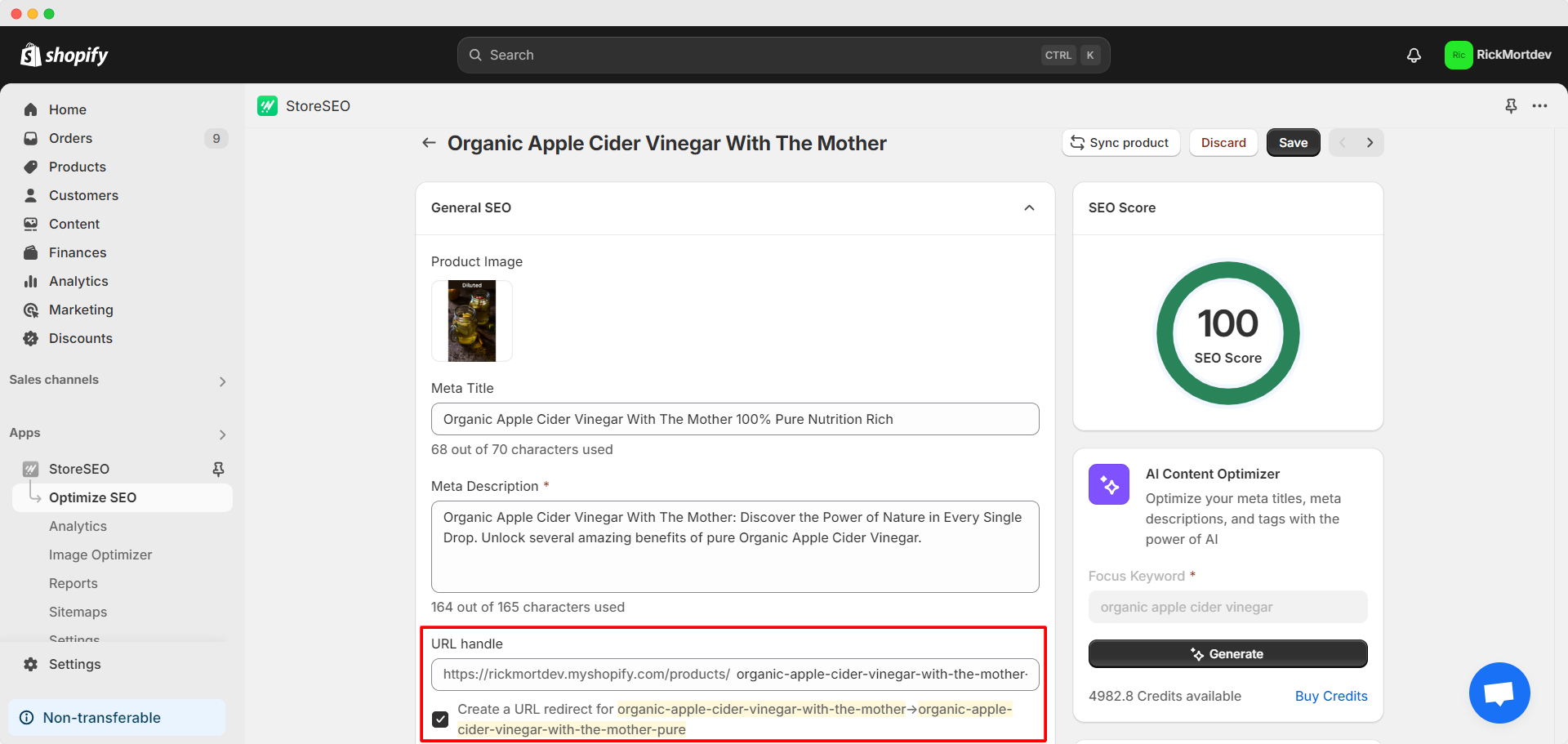
Write a product description of 50 to 300 words
Make sure that the product description shown previously contains 50 to 300 words. As you can see, we have written our product description accordingly to ensure the best SEO results. Read this blog to find out how to write unique product descriptions in Shopify.
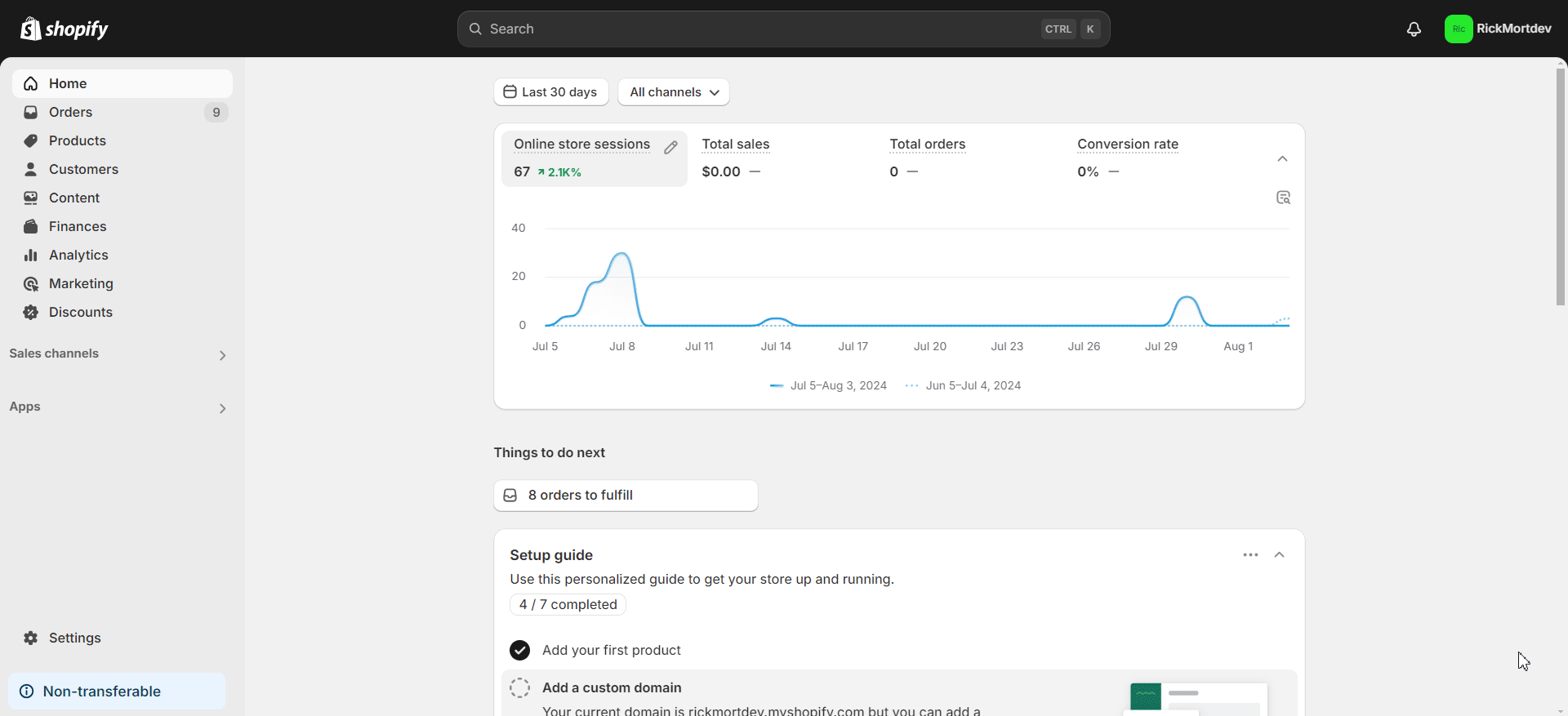
Add alt text to all images
If you have multiple images for your product, ensure that the Focus Keyword is used in the alt text of all images. As you can see in the image below, we have used our selected Focus Keyword in the alt text of all our product images.
We have used the following image alt text: Organic Apple Cider Vinegar Machine Pressed 100 ml, Organic Apple Cider Vinegar Hand Pressed 100 ml and Organic Apple Cider Vinegar Diluted 100 ml. All contain ‘Organic Apple Cider Vinegar’ or our selected Focus Keyword.
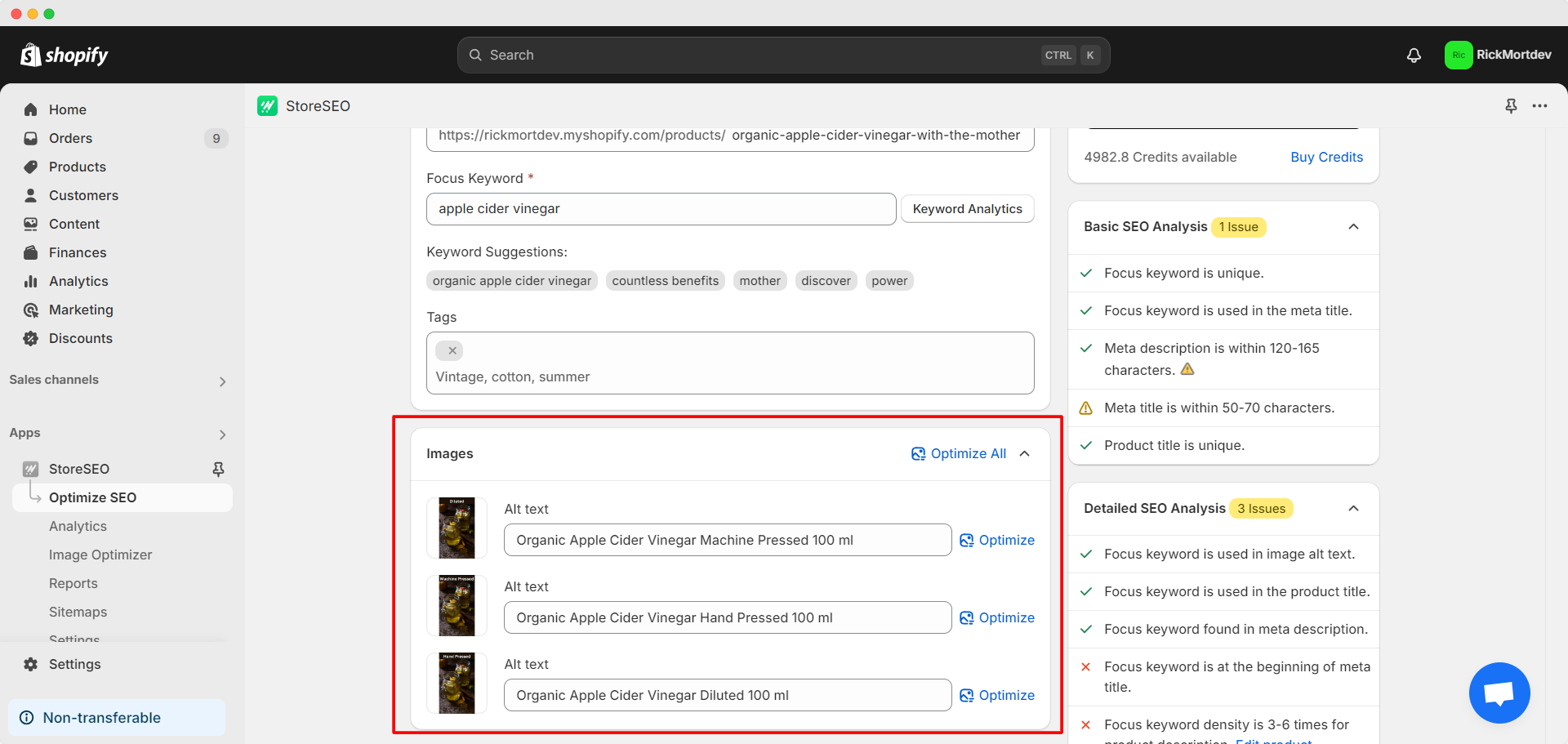
All Images are optimized
Remember to optimize all the images used for the product. With StoreSEO, you can optimize images on Shopify with ease. When optimizing a product with StoreSEO, click on the ‘Optimize’ button beside each image to optimize it individually. You can also click on the ‘Optimize All’ button to optimize all of the images at once.
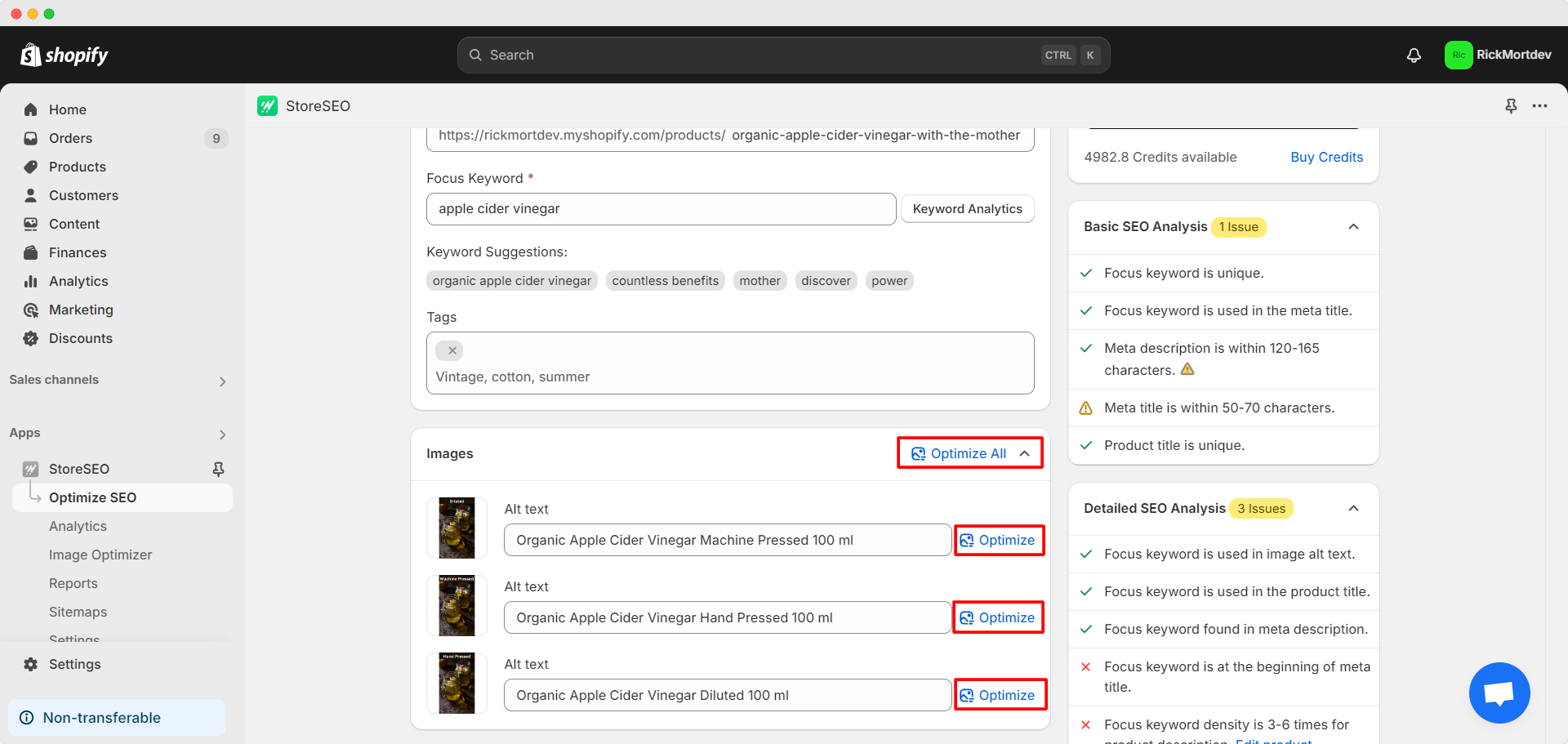
To optimize all your store’s images in one place, select the ‘Image Optimizer’ tab under StoreSEO from the left sidebar. Here, you can optimize images, restore optimized images to the original and compare the restored and original versions under Action as shown below.
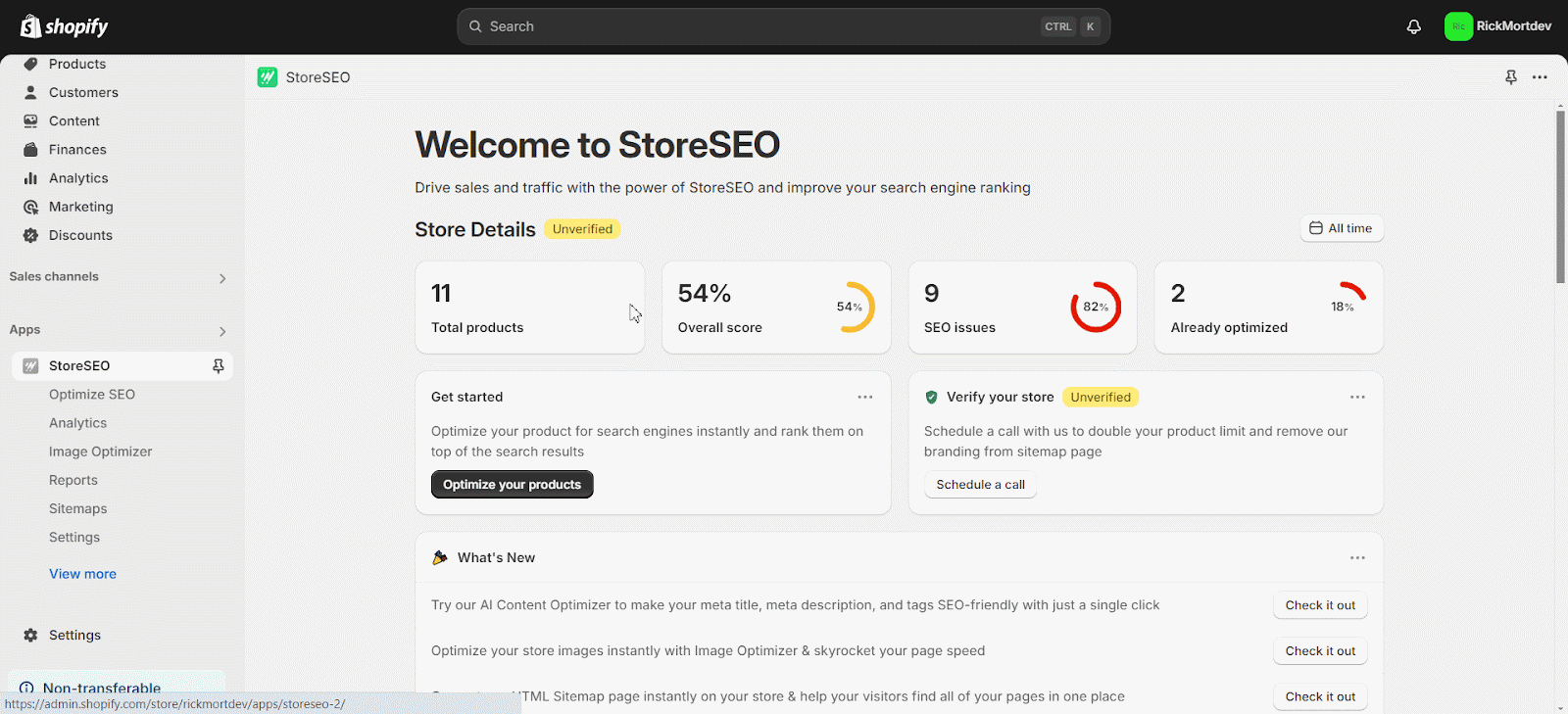
For additional settings, click on the ‘Settings’ tab in the left sidebar. Then, choose the ‘Image Optimizer’ option. Turn on ‘Auto Image Optimization’ option to automatically have your images optimized upon upload. You can also choose your desired image compression and image format settings along with the output dimension for the resized image. Click on the ‘Save’ button when you are done.
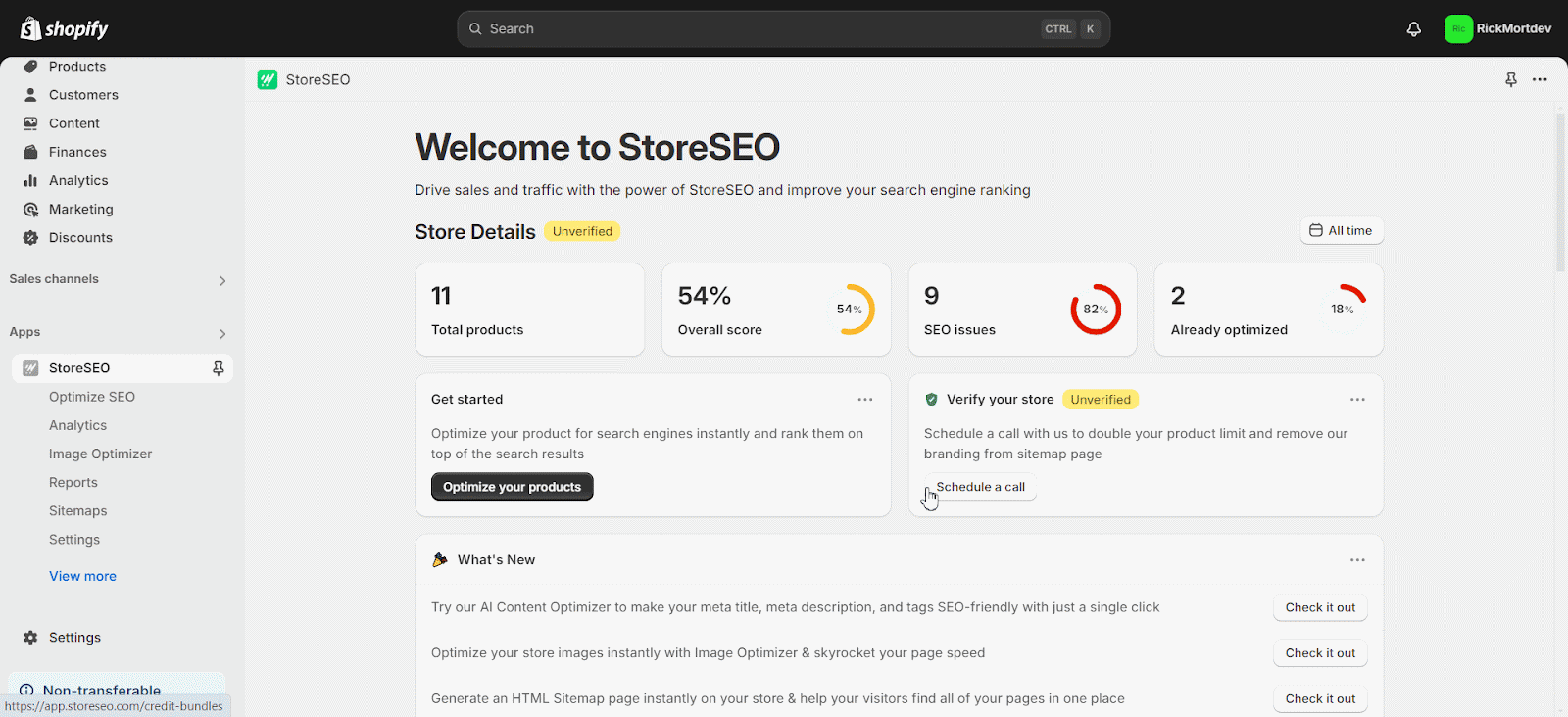
By following these steps, you can address every important SEO factor for the best possible optimization score for your product page. If you need help to optimize your content for SEO, you can also use the StoreSEO AI Content Optimizer.
Once you are done with your product optimization and happy with the overall SEO Score, click on the ‘Save’ button.
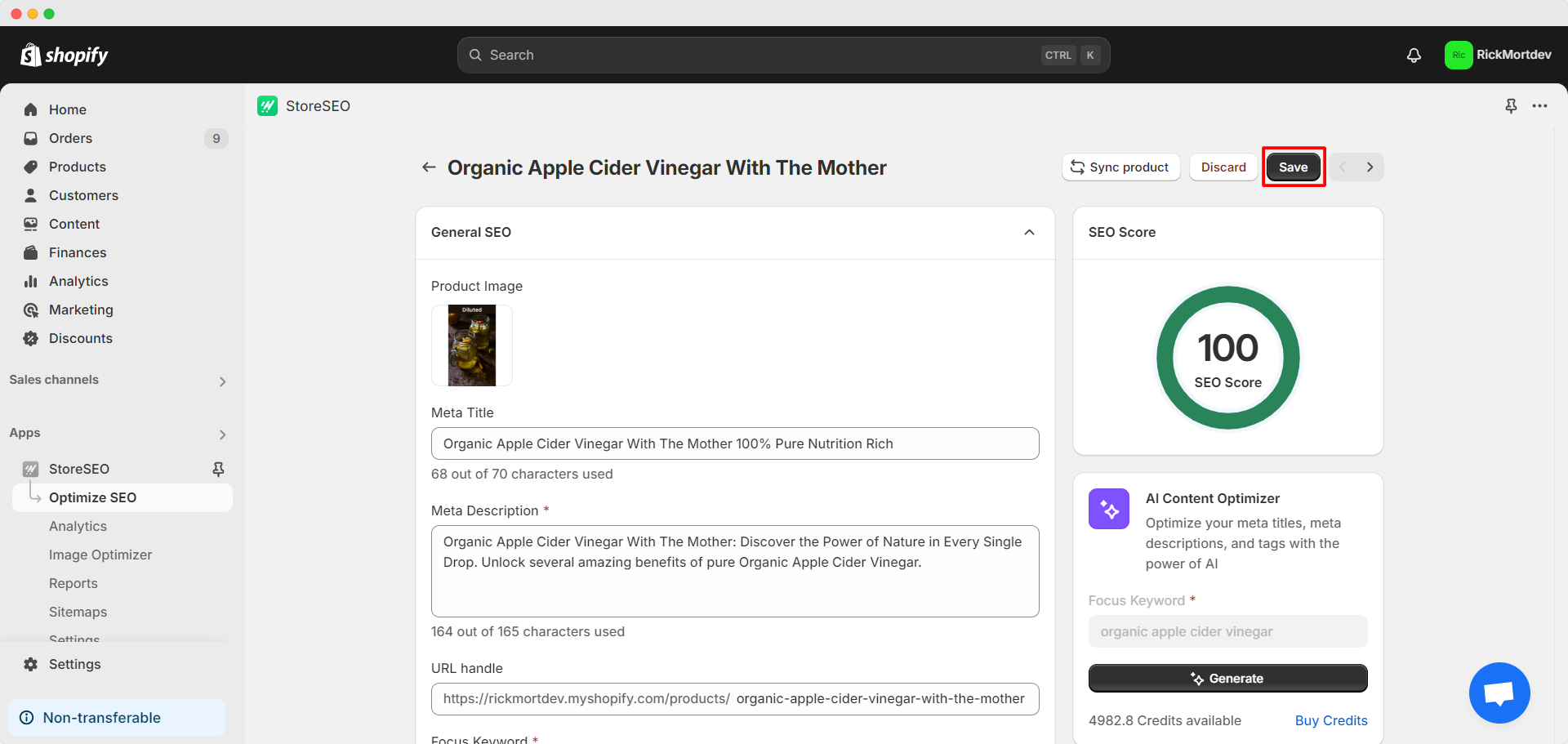
This is how easily you can optimize Shopify Product Pages with StoreSEO. Need assistance? Feel free to reach out to our dedicated support team for any type of query.







